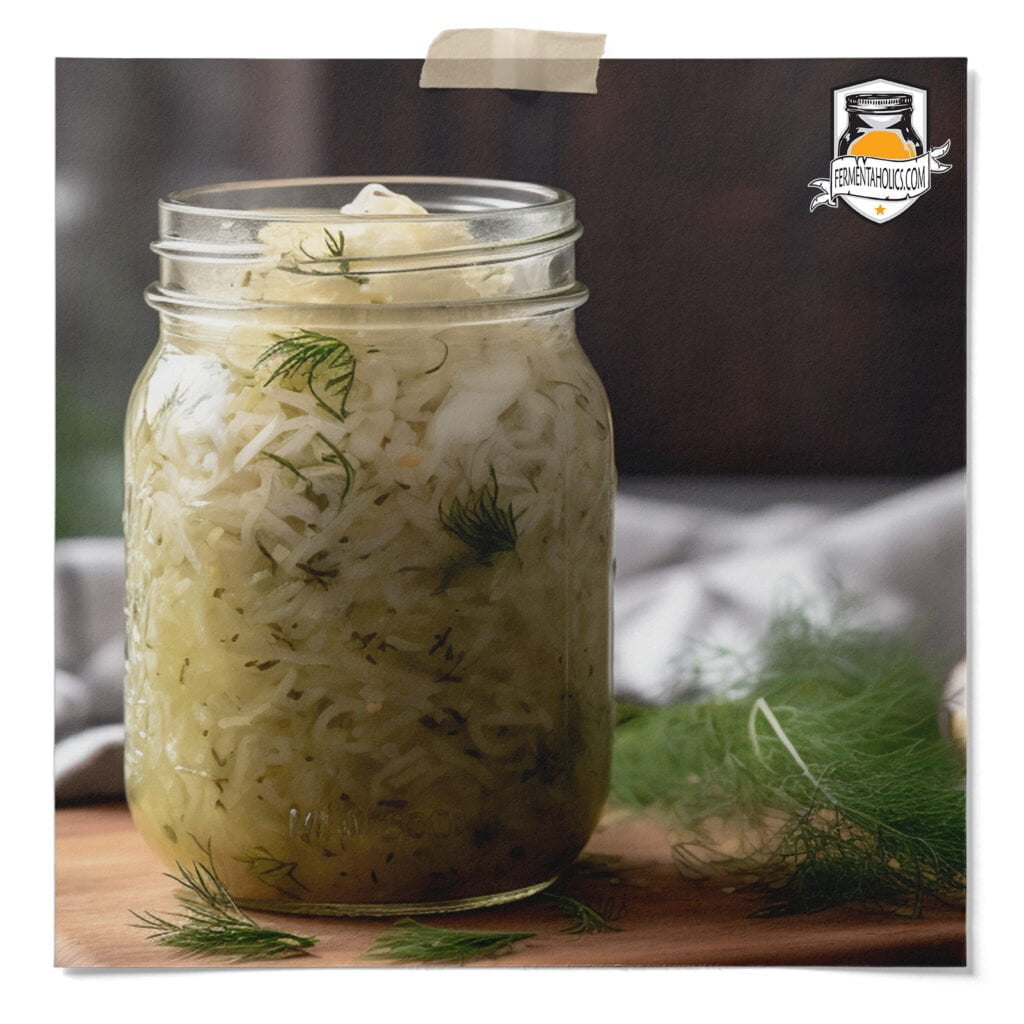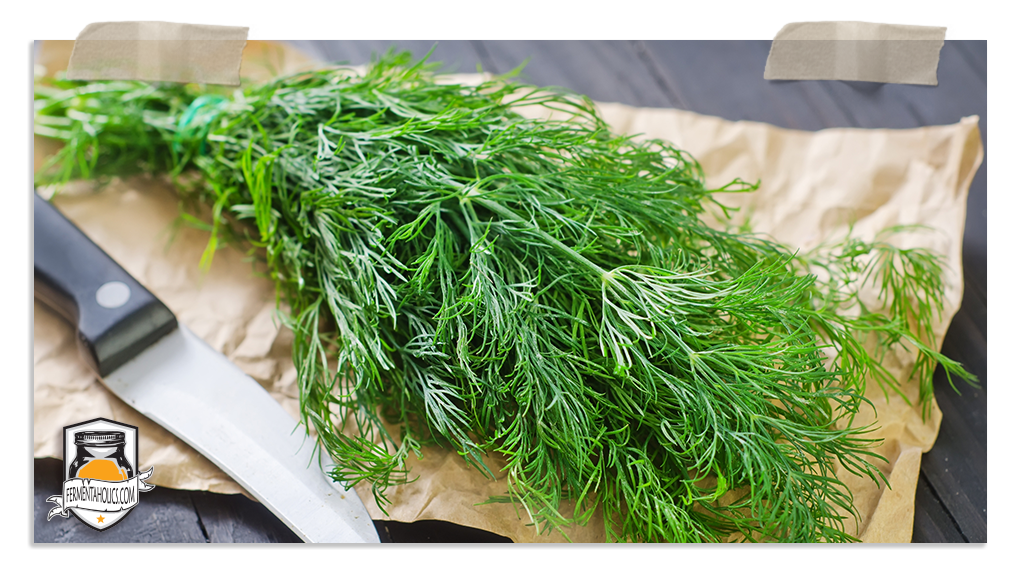
Sauerkraut is a timeless fermented food that has captured people’s taste buds worldwide. Various versions of sauerkraut are found around the world, each showcasing cultural diversity and culinary creativity. You’ll find sauerkraut made using white cabbage in Germany. In Korea, traditional kimchi, a form of sauerkraut, features napa cabbage combined with spicy seasonings like garlic and gochugaru, a Korean chili pepper. Traditional sauerkraut is a simple mixture of cabbage and salt that is fermented over a period of time. We will change things a little for today’s recipe and add a fresh, aromatic twist: dill. That’s right; today, we’re learning how to make dill sauerkraut.


Before we dive into the dill sauerkraut recipe, it’s important to understand a little about fermentation. Fermentation is the process that turns fresh cabbage into sauerkraut. Fermentation is a natural process in which microorganisms, such as yeast and bacteria, convert sugars into alcohol or acids.
In the case of sauerkraut, it’s lactic acid fermentation or just lacto fermentation. Lacto fermentation is the process in which beneficial bacteria convert the sugars in the cabbage into lactic acid. Not only does this help to preserve the cabbage, but it also gives sauerkraut its characteristic tangy flavor and is responsible for its probiotics nature.
Making dill sauerkraut at home is not only a fun experiment, but it’s also a healthier alternative to store-bought versions. There are no artificial preservatives or excess salt, and you control the ingredients. In addition, homemade sauerkraut is full of probiotics – beneficial bacteria that help support gut health.
So, why use dill? Well, that’s easy. Dill complements the taste of sauerkraut perfectly. Dills distinct flavor and aroma have a way of blending and tying together the acidic nature of the sauerkraut.
It’s a good source of fiber, vitamins A and C, folic acid, calcium, iron, and manganese. Adding it to your sauerkraut will improve the nutritional profile of the dish.
1
Quart Jar15
MinutesVaries
To TasteThis recipe will make a quart-sized jar of dill sauerkraut. Before we get started, we will need to gather some basic supplies and ingredients. Here is what we'll need:
1 medium green cabbage (about 2 lbs), quartered and sliced into thin strips. Reserve one of the outer leaves to use as a follower.
1 heaping cup of fresh dill, finely chopped
1 tbsp pink himalayan sea salt or another non-iodized salt of your choice.
Sharp knife
Measuring Spoons
Quart-sized Mason jar
Extra-large bowl.
Place the thinly sliced cabbage into a large bowl.
Sprinkle all the salt over the cabbage. Mix well with your clean hands and massage the salt into the cabbage. This is important as the salt helps draw out the water, which helps the cabbage ferment.
Crush the cabbage with the help of the tamper. Pound it for a minute, rest for a few minutes, and then repeat. The salt and pounding extract the water from the shredded cabbage, creating your brine.
Once you see liquid accumulating at the bottom of the bowl, go ahead and add the dill. Mix well to ensure that the cabbage and dill are thoroughly combined.
Pack the cabbage mixture tightly into the glass jar. Use the tamper to compact the cabbage as much as possible, then pour in the brine. Make sure that the liquid completely covers the cabbage.
Place the reserved cabbage leaf to create a barrier so the small pieces of cabbage don't float up. Then, put the glass weight on top, pressing down to keep everything below the liquid.
Cover the jar with a fermentation stretch lid or lid with an airlock of your choice and place it in a warm spot to ferment. Allow to ferment until the sauerkraut reaches your preferred balance of flavor and texture.
Here are a few tips and pointers to help ensure a successful fermentation:
This is essential to prevent mold growth. If you notice that the cabbage is rising above the brine, you can use the tamper to push it back down again. That’s why the reserved cabbage leaf and the glass weight are essential in keeping everything under the brine.
If you’re using an airlock lid, the risk of mold growth is greatly reduced. However, if you’re using one of the various DIY contraptions, you’ll need to keep a closer eye on it. If you see a whitish film on the surface, don’t panic. It’s probably Kahm yeast, which isn’t harmful but can affect the taste. You can skim it off. However, if you are unlucky and get mold, then it’s time to toss and start fresh.
Fermentation is a slow process, so be patient. Let nature take its course, and you’ll be rewarded with a deliciously tangy dill sauerkraut.
A natural part of the fermentation process is a strong smell. Don’t be afraid; it’s not necessarily a sign that your sauerkraut has gone bad.
Sauerkraut is versatile. You can use it as a side dish, add it to sandwiches or salads, or even incorporate it into your favorite recipes. Its distinctive tangy flavor and fresh dill aroma will enhance any meal.
To sum up, making dill sauerkraut at home is a rewarding process. It’s science combined with art and allows you to experience the transformative power of fermentation firsthand. So gather up your ingredients and equipment, roll up your sleeves, and start your fermentation journey. With a little patience and a bit of practice, you’ll soon be enjoying your very own homemade dill sauerkraut.

Yes, while dill is a common flavoring, other herbs and spices can be added to sauerkraut for variety. Popular additions include caraway seeds, garlic, and juniper berries.
Dill Sauerkraut should be stored in an airtight container in the refrigerator to preserve its freshness and prevent spoilage.
Yes, Dill Sauerkraut, like other fermented foods, contains beneficial probiotics that can promote gut health and aid digestion.
Signs of spoilage include an off or rotten smell, mold growth, or a slimy texture. If any of these are observed, it’s best to discard the product.
While any type of cabbage can be used, green cabbage is most commonly used for making sauerkraut. However, you can experiment with other varieties for different flavors and textures.
The cabbage should be washed, cored, and thinly sliced or shredded. Removing the tough outer leaves before slicing is also recommended.
Fermentation speed is influenced by temperature. Warmer environments (within safety limits) can accelerate fermentation. However, quicker fermentation may result in a slightly different flavor profile.
